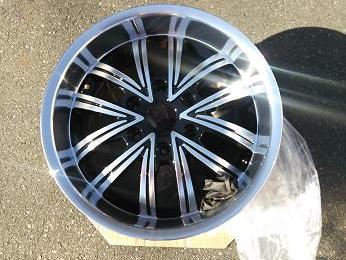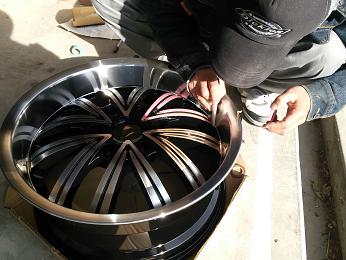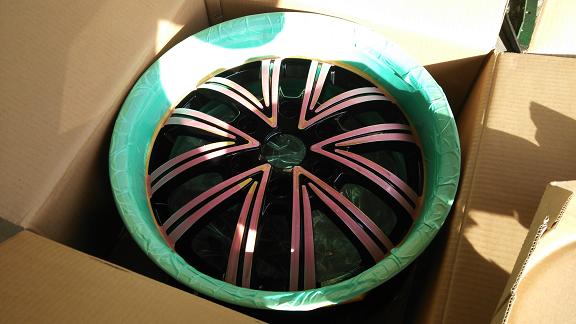アルミ塗装 ハイエース
2014年01月06日
日頃よりお世話になってるW社長よりお預かりした
仕事用のハイエース スーパーGL
定期点検のついでにタイヤ交換のご依頼を頂いたのですが
W社長↓
どうせならアルミも交換して!
なんかいい感じにして!
任せるよ!
センス良く仕上げろ!
了解しました。
アルミは最近の流行だと普通なのでリムがあるタイプをチョイス
19/20インチだと乗り心地が悪いので18インチ!
ベースのハイエースはW社長こだわりの
ワインレッドのオールペイントされた車なので・・・・
アルミも塗ることにしました。
全部塗るかシルバー部(ポリッシュ)を塗れば簡単ですが
車両とのバランスを考えて困難な黒部を塗ることに・・・・
コレが大変な判断でした
マスキングをするにも細すぎる!
でも当社の職人は匠技で・・・・
綺麗にマスキングしちゃいます!
※次回はアルミ買う前に相談してって怒られました(笑)
完成車両がこちら!!!
ワインレッドとシルバーの綺麗な配色
フロントタイヤ
リアタイヤ
リアから
W社長からも
マスキングしたの?大変だったろ?でも凄く良いよ!
ってお褒めのお言葉を頂きました。
人とはチョット違ったカスタムもご依頼下さい。
当社の板金工場では匠が職人技で仕上げます!
もちろんロープライスです
気になった方はご連絡お待ちしております
担当 齊藤
この記事へのコメント
(Latoya)
BPC?157 is a synthetic peptide that has gained significant attention in the realm of sports medicine and recovery protocols.
The Infiniwell brand offers its own formulation of this compound, marketed
as a supplement designed to accelerate tissue repair and enhance overall physiological resilience.
Below you will find an in?depth review of Infiniwell’s
BPC?157 product, a clear explanation of what BPC?157 actually
is, and a summary of the most recent user experiences
reported across various platforms.
---
Supplement Review: BPC?157 by Infiniwell
Infiniwell presents its BPC?157 supplement in a powder form that can be reconstituted with sterile
water or another suitable solvent. The typical dosage recommendation ranges from 0.2 to 1 milligram per day,
though many users adjust the amount based on their specific injury type and severity.
A key selling point of Infiniwell’s product is its emphasis on purity: the manufacturer claims that each batch
undergoes rigorous testing for contaminants such as heavy metals, endotoxins, and residual solvents.
Packaging and Ease of Use
The supplement comes in a small glass vial with an attached syringe.
The vial is sealed under inert conditions to minimize oxidation of the peptide, which is known to be somewhat unstable when exposed to air for extended periods.
Users appreciate that the product includes a detailed instruction sheet, complete with recommended reconstitution volumes and storage guidelines (refrigeration below
4°C is advised once mixed).
Ingredient Profile
The core ingredient is the synthetic peptide BPC?157, also referred
to as Body Protection Compound 157. The formulation contains no additional fillers or binders, which
is a common concern for athletes who wish to avoid unnecessary
additives that could affect performance or introduce allergens.
Cost and Value
Infiniwell’s pricing strategy places it in the mid?tier of peptide supplements on the market.
While the upfront cost per vial may seem higher than some generic alternatives,
many users justify this by citing the product’s consistent potency as
verified through third?party lab reports. Bulk purchasing options are available for those who
plan to use the supplement over a longer period.
User Experience
On average, reviewers report that Infiniwell BPC?157 is easy to handle and does not produce noticeable side effects
when taken within recommended dosages. The main reported benefits revolve around reduced inflammation, faster healing of tendon injuries, and improved joint mobility.
Some users also mention an increase in overall energy levels, though this effect may be indirect, stemming
from better recovery rather than a direct stimulant.
---
What is BPC?157?
BPC?157 is a pentadecapeptide, meaning it consists
of fifteen amino acids. It was originally derived from a protein fragment found in human gastric
juice. The peptide has been studied extensively
in animal models, where it demonstrated remarkable regenerative properties across multiple tissues:
Musculoskeletal Repair ? BPC?157 promotes the healing of tendons, ligaments,
and muscle fibers by stimulating angiogenesis (the formation of new blood vessels) and modulating inflammatory
pathways.
Joint Health ? The peptide has been shown to reduce cartilage degradation in osteoarthritis models,
thereby preserving joint function.
Neuroprotection ? Preliminary research suggests BPC?157
may support neuronal regeneration following injury or ischemic
events.
Gastrointestinal Healing ? As its name implies, the compound can accelerate the repair of
gastric ulcers and inflammatory bowel conditions.
Mechanistically, BPC?157 is believed to act through several signaling cascades, including the
vascular endothelial growth factor (VEGF) pathway, the nitric oxide system, and various cytokine modulators.
This multifaceted approach enables it to address both macro?level tissue damage and micro?level cellular dysfunction.
Despite promising preclinical data, human studies remain limited.
The peptide is not yet approved by major regulatory agencies such
as the Food and Drug Administration for clinical use, so most available products are marketed as research chemicals or dietary supplements rather than prescription medications.
---
Latest Reviews
Recent feedback from a broad spectrum of users?ranging from professional athletes to casual fitness enthusiasts?provides a nuanced picture
of Infiniwell BPC?157’s real?world performance.
Here is an overview of the most common themes found in reviews posted over the last six months:
Positive Outcomes
Rapid Tendon Healing ? Many reviewers who suffered tendonitis or pulled hamstrings reported noticeable improvements within 2 to 4 weeks of consistent
use.
Reduced Inflammation ? Users with chronic joint pain noted a marked decrease
in swelling and stiffness, often allowing them to resume high?intensity training earlier than expected.
Improved Recovery Time ? Several athletes claimed that workouts
felt less taxing and soreness subsided more quickly when they incorporated
the peptide into their regimen.
Neutral or Mixed Feedback
Variable Response Rates ? Some individuals experienced minimal change in symptoms,
suggesting that BPC?157’s efficacy may depend on factors such as injury
type, dosage adherence, or individual metabolic differences.
Side Effects ? A small subset of reviewers mentioned mild tingling sensations at the injection site (if used subcutaneously) or transient headaches.
These reports were generally short?lived and
resolved without intervention.
Criticisms
Cost Concerns ? While many praised the quality, a number of
users felt that the price point was high relative to generic alternatives.
Availability Issues ? A few reviewers noted difficulties in obtaining consistent shipping
due to regulatory restrictions on peptide distribution in certain regions.
Lack of Clinical Evidence ? Some skeptical commenters highlighted the absence of large?scale human trials, urging caution for
those who might be considering it as a primary
treatment.
Overall Sentiment
The majority of recent reviews lean towards a positive assessment
of Infiniwell BPC?157, especially when used as part of a
comprehensive recovery protocol that includes proper nutrition, rest, and physical therapy.
Users frequently emphasize the importance of following dosage guidelines meticulously, as inconsistent dosing can lead to less predictable results.
---
In conclusion, Infiniwell’s BPC?157 supplement presents itself as a high?quality option for individuals looking to support tissue
repair and reduce inflammation. While the scientific community still awaits robust human trials, the current body
of anecdotal evidence suggests that many users experience tangible benefits in terms of faster healing and
improved joint function. As with any performance?enhancing
compound, potential users should consult healthcare professionals before
starting treatment, particularly if they have underlying medical conditions or are taking other medications.
The Infiniwell brand offers its own formulation of this compound, marketed
as a supplement designed to accelerate tissue repair and enhance overall physiological resilience.
Below you will find an in?depth review of Infiniwell’s
BPC?157 product, a clear explanation of what BPC?157 actually
is, and a summary of the most recent user experiences
reported across various platforms.
---
Supplement Review: BPC?157 by Infiniwell
Infiniwell presents its BPC?157 supplement in a powder form that can be reconstituted with sterile
water or another suitable solvent. The typical dosage recommendation ranges from 0.2 to 1 milligram per day,
though many users adjust the amount based on their specific injury type and severity.
A key selling point of Infiniwell’s product is its emphasis on purity: the manufacturer claims that each batch
undergoes rigorous testing for contaminants such as heavy metals, endotoxins, and residual solvents.
Packaging and Ease of Use
The supplement comes in a small glass vial with an attached syringe.
The vial is sealed under inert conditions to minimize oxidation of the peptide, which is known to be somewhat unstable when exposed to air for extended periods.
Users appreciate that the product includes a detailed instruction sheet, complete with recommended reconstitution volumes and storage guidelines (refrigeration below
4°C is advised once mixed).
Ingredient Profile
The core ingredient is the synthetic peptide BPC?157, also referred
to as Body Protection Compound 157. The formulation contains no additional fillers or binders, which
is a common concern for athletes who wish to avoid unnecessary
additives that could affect performance or introduce allergens.
Cost and Value
Infiniwell’s pricing strategy places it in the mid?tier of peptide supplements on the market.
While the upfront cost per vial may seem higher than some generic alternatives,
many users justify this by citing the product’s consistent potency as
verified through third?party lab reports. Bulk purchasing options are available for those who
plan to use the supplement over a longer period.
User Experience
On average, reviewers report that Infiniwell BPC?157 is easy to handle and does not produce noticeable side effects
when taken within recommended dosages. The main reported benefits revolve around reduced inflammation, faster healing of tendon injuries, and improved joint mobility.
Some users also mention an increase in overall energy levels, though this effect may be indirect, stemming
from better recovery rather than a direct stimulant.
---
What is BPC?157?
BPC?157 is a pentadecapeptide, meaning it consists
of fifteen amino acids. It was originally derived from a protein fragment found in human gastric
juice. The peptide has been studied extensively
in animal models, where it demonstrated remarkable regenerative properties across multiple tissues:
Musculoskeletal Repair ? BPC?157 promotes the healing of tendons, ligaments,
and muscle fibers by stimulating angiogenesis (the formation of new blood vessels) and modulating inflammatory
pathways.
Joint Health ? The peptide has been shown to reduce cartilage degradation in osteoarthritis models,
thereby preserving joint function.
Neuroprotection ? Preliminary research suggests BPC?157
may support neuronal regeneration following injury or ischemic
events.
Gastrointestinal Healing ? As its name implies, the compound can accelerate the repair of
gastric ulcers and inflammatory bowel conditions.
Mechanistically, BPC?157 is believed to act through several signaling cascades, including the
vascular endothelial growth factor (VEGF) pathway, the nitric oxide system, and various cytokine modulators.
This multifaceted approach enables it to address both macro?level tissue damage and micro?level cellular dysfunction.
Despite promising preclinical data, human studies remain limited.
The peptide is not yet approved by major regulatory agencies such
as the Food and Drug Administration for clinical use, so most available products are marketed as research chemicals or dietary supplements rather than prescription medications.
---
Latest Reviews
Recent feedback from a broad spectrum of users?ranging from professional athletes to casual fitness enthusiasts?provides a nuanced picture
of Infiniwell BPC?157’s real?world performance.
Here is an overview of the most common themes found in reviews posted over the last six months:
Positive Outcomes
Rapid Tendon Healing ? Many reviewers who suffered tendonitis or pulled hamstrings reported noticeable improvements within 2 to 4 weeks of consistent
use.
Reduced Inflammation ? Users with chronic joint pain noted a marked decrease
in swelling and stiffness, often allowing them to resume high?intensity training earlier than expected.
Improved Recovery Time ? Several athletes claimed that workouts
felt less taxing and soreness subsided more quickly when they incorporated
the peptide into their regimen.
Neutral or Mixed Feedback
Variable Response Rates ? Some individuals experienced minimal change in symptoms,
suggesting that BPC?157’s efficacy may depend on factors such as injury
type, dosage adherence, or individual metabolic differences.
Side Effects ? A small subset of reviewers mentioned mild tingling sensations at the injection site (if used subcutaneously) or transient headaches.
These reports were generally short?lived and
resolved without intervention.
Criticisms
Cost Concerns ? While many praised the quality, a number of
users felt that the price point was high relative to generic alternatives.
Availability Issues ? A few reviewers noted difficulties in obtaining consistent shipping
due to regulatory restrictions on peptide distribution in certain regions.
Lack of Clinical Evidence ? Some skeptical commenters highlighted the absence of large?scale human trials, urging caution for
those who might be considering it as a primary
treatment.
Overall Sentiment
The majority of recent reviews lean towards a positive assessment
of Infiniwell BPC?157, especially when used as part of a
comprehensive recovery protocol that includes proper nutrition, rest, and physical therapy.
Users frequently emphasize the importance of following dosage guidelines meticulously, as inconsistent dosing can lead to less predictable results.
---
In conclusion, Infiniwell’s BPC?157 supplement presents itself as a high?quality option for individuals looking to support tissue
repair and reduce inflammation. While the scientific community still awaits robust human trials, the current body
of anecdotal evidence suggests that many users experience tangible benefits in terms of faster healing and
improved joint function. As with any performance?enhancing
compound, potential users should consult healthcare professionals before
starting treatment, particularly if they have underlying medical conditions or are taking other medications.
[2025-10-06 20:22:38.123125]
URL
(Hildegard)
Ipamorelin and CJC?1295 are two popular growth hormone releasing peptides that are often paired together in what is known as the "GHRP?CJC" stack.
Both agents aim to increase circulating levels of
human growth hormone, but they work through slightly different mechanisms and have distinct side effect profiles.
Understanding how each peptide functions, what specific adverse reactions
may arise, and how the two compare can help users make
more informed decisions about their use.
Ipamorelin vs CJC?1295
Ipamorelin is a pentapeptide that acts as a selective ghrelin receptor agonist.
It stimulates the pituitary gland to secrete growth hormone without markedly raising prolactin or cortisol levels, which makes it relatively mild in its hormonal
side effects. CJC?1295, on the other hand, is a larger peptide that includes a PEGylated
(polyethylene glycol) tail to extend its half?life.
It binds to GHRH receptors and also promotes growth hormone
release, but because of its longer duration it can lead
to more pronounced changes in insulin-like growth factor 1 (IGF?1).
The stack is designed so that Ipamorelin provides a quick spike while CJC?1295 sustains the effect.
Users often report improved sleep quality, increased lean muscle mass, and enhanced recovery from this combination.
Because of these pharmacokinetic differences,
side effects can also diverge. Ipamorelin’s short action usually
limits acute reactions, whereas CJC?1295’s prolonged presence may lead to more persistent alterations
in hormone levels. The stack can amplify both sets of
side effects, so monitoring is essential.
What Is Ipamorelin?
Ipamorelin is a synthetic growth hormone releasing peptide that mimics the natural hormone ghrelin. It
binds specifically to the ghrelin receptor (GHSR?1a) on pituitary somatotrophs, prompting them to release growth hormone into circulation.
The structure of Ipamorelin is designed to be resistant to enzymatic degradation, giving it a useful half?life of about 30?45 minutes when injected.
Because it selectively stimulates growth hormone without significantly affecting prolactin or cortisol, many users consider it
safer for long?term use.
Typical dosing ranges from 100??g to 300??g per injection, often administered
twice daily (morning and night). Users report increased energy, improved appetite,
and a feeling of vitality. The most common side
effects are mild and include local injection site reactions such as
pain or swelling, transient headaches, and occasional water retention leading to puffiness around the face.
FAQs: Ipamorelin vs CJC?1295
Can I use Ipamorelin alone without CJC?1295?
Yes, many people take Ipamorelin on its own for a quick growth hormone boost.
However, the effect is short-lived, so results may be less pronounced
than with the full stack.
Does combining them increase risk of side effects?
The combination can intensify certain reactions, particularly water retention and increased IGF?1 levels.
Monitoring blood work and staying hydrated can mitigate
these risks.
What are the most common adverse events from CJC?1295 alone?
Users may experience joint pain, muscle aches, and mild swelling.
Because of its PEGylated tail, it can also cause a sensation of fullness or bloating for several hours after
injection.
Will the stack affect my menstrual cycle or testosterone levels?
Generally, neither peptide has a direct effect on sex hormones
at typical dosages. However, long?term growth hormone elevation may
indirectly influence hormonal balance in some individuals.
Is there an upper safe dose for CJC?1295?
Doses above 300??g per injection are rarely recommended due to increased risk
of side effects and diminishing returns. The most common regimen is 150?200??g twice
daily.
How long does it take to see results from the stack?
Most users notice improved sleep quality and muscle tone within two weeks, while significant increases in lean body mass usually appear after a month of consistent use.
Can I cycle these peptides or do they need to be taken continuously?
Many protocols recommend 8?12 week cycles followed by a break of similar
length. This helps prevent tolerance buildup and allows the body’s
natural hormone production to recover.
What monitoring should I perform while on this stack?
Routine blood tests for IGF?1, insulin, cortisol, and
thyroid function are advised. Checking creatinine kinase can also
detect potential muscle damage early.
Do these peptides cause weight gain or fat loss?
Ipamorelin’s appetite-stimulating effect
may lead to modest weight gain if caloric intake is not controlled.
CJC?1295 can promote fat mobilization, so combining them with a balanced diet often results in a leaner
physique.
Are there any long-term safety concerns?
Current research suggests that short- to medium-term use of these peptides is relatively safe when dosed properly.
Long-term effects remain under study, particularly concerning cancer
risk and endocrine disruption. Users should stay informed
about emerging data and consult healthcare professionals before prolonged usage.
In summary, Ipamorelin offers a selective, mild growth hormone stimulus with minimal hormonal side effects, while CJC?1295 provides a sustained release
that can amplify both benefits and risks. The stack
is popular for its synergistic effect on muscle gain and recovery but requires careful dosing, monitoring, and lifestyle management to keep side
effects at bay.
Both agents aim to increase circulating levels of
human growth hormone, but they work through slightly different mechanisms and have distinct side effect profiles.
Understanding how each peptide functions, what specific adverse reactions
may arise, and how the two compare can help users make
more informed decisions about their use.
Ipamorelin vs CJC?1295
Ipamorelin is a pentapeptide that acts as a selective ghrelin receptor agonist.
It stimulates the pituitary gland to secrete growth hormone without markedly raising prolactin or cortisol levels, which makes it relatively mild in its hormonal
side effects. CJC?1295, on the other hand, is a larger peptide that includes a PEGylated
(polyethylene glycol) tail to extend its half?life.
It binds to GHRH receptors and also promotes growth hormone
release, but because of its longer duration it can lead
to more pronounced changes in insulin-like growth factor 1 (IGF?1).
The stack is designed so that Ipamorelin provides a quick spike while CJC?1295 sustains the effect.
Users often report improved sleep quality, increased lean muscle mass, and enhanced recovery from this combination.
Because of these pharmacokinetic differences,
side effects can also diverge. Ipamorelin’s short action usually
limits acute reactions, whereas CJC?1295’s prolonged presence may lead to more persistent alterations
in hormone levels. The stack can amplify both sets of
side effects, so monitoring is essential.
What Is Ipamorelin?
Ipamorelin is a synthetic growth hormone releasing peptide that mimics the natural hormone ghrelin. It
binds specifically to the ghrelin receptor (GHSR?1a) on pituitary somatotrophs, prompting them to release growth hormone into circulation.
The structure of Ipamorelin is designed to be resistant to enzymatic degradation, giving it a useful half?life of about 30?45 minutes when injected.
Because it selectively stimulates growth hormone without significantly affecting prolactin or cortisol, many users consider it
safer for long?term use.
Typical dosing ranges from 100??g to 300??g per injection, often administered
twice daily (morning and night). Users report increased energy, improved appetite,
and a feeling of vitality. The most common side
effects are mild and include local injection site reactions such as
pain or swelling, transient headaches, and occasional water retention leading to puffiness around the face.
FAQs: Ipamorelin vs CJC?1295
Can I use Ipamorelin alone without CJC?1295?
Yes, many people take Ipamorelin on its own for a quick growth hormone boost.
However, the effect is short-lived, so results may be less pronounced
than with the full stack.
Does combining them increase risk of side effects?
The combination can intensify certain reactions, particularly water retention and increased IGF?1 levels.
Monitoring blood work and staying hydrated can mitigate
these risks.
What are the most common adverse events from CJC?1295 alone?
Users may experience joint pain, muscle aches, and mild swelling.
Because of its PEGylated tail, it can also cause a sensation of fullness or bloating for several hours after
injection.
Will the stack affect my menstrual cycle or testosterone levels?
Generally, neither peptide has a direct effect on sex hormones
at typical dosages. However, long?term growth hormone elevation may
indirectly influence hormonal balance in some individuals.
Is there an upper safe dose for CJC?1295?
Doses above 300??g per injection are rarely recommended due to increased risk
of side effects and diminishing returns. The most common regimen is 150?200??g twice
daily.
How long does it take to see results from the stack?
Most users notice improved sleep quality and muscle tone within two weeks, while significant increases in lean body mass usually appear after a month of consistent use.
Can I cycle these peptides or do they need to be taken continuously?
Many protocols recommend 8?12 week cycles followed by a break of similar
length. This helps prevent tolerance buildup and allows the body’s
natural hormone production to recover.
What monitoring should I perform while on this stack?
Routine blood tests for IGF?1, insulin, cortisol, and
thyroid function are advised. Checking creatinine kinase can also
detect potential muscle damage early.
Do these peptides cause weight gain or fat loss?
Ipamorelin’s appetite-stimulating effect
may lead to modest weight gain if caloric intake is not controlled.
CJC?1295 can promote fat mobilization, so combining them with a balanced diet often results in a leaner
physique.
Are there any long-term safety concerns?
Current research suggests that short- to medium-term use of these peptides is relatively safe when dosed properly.
Long-term effects remain under study, particularly concerning cancer
risk and endocrine disruption. Users should stay informed
about emerging data and consult healthcare professionals before prolonged usage.
In summary, Ipamorelin offers a selective, mild growth hormone stimulus with minimal hormonal side effects, while CJC?1295 provides a sustained release
that can amplify both benefits and risks. The stack
is popular for its synergistic effect on muscle gain and recovery but requires careful dosing, monitoring, and lifestyle management to keep side
effects at bay.
[2025-10-05 22:57:52.943528]
URL
(Madeleine)
Metandienone Wikipedia
**N?Butyl?Aniline (C?H??N): A Review
of Its Pharmacology, Toxicity and Legal Status**
---
### 1. Introduction
N?butyl?aniline (also called **p?n?butylaniline**) is a colourless to pale?yellow liquid that is soluble in most organic solvents but only sparingly soluble in water.
It is used industrially as an intermediate for the manufacture of dyes, pigments and pharmaceuticals, and occasionally as a flavouring or fragrance component in small amounts.
---
### 2. Chemical Properties
| Property | Value |
|---|---|
| Formula | C?H??N |
| Molecular weight | 119.19?g?mol?? |
| Boiling point | ~207?°C (1?atm) |
| Melting point | ?60?°C |
| Density | 0.91?g?cm?? at 25?°C |
| Solubility in water | <0.5?mg?mL?? |
| Solubility in ethanol | miscible |
---
### 3. Biological Activity
#### a) In vitro Cytotoxicity
- **Cell lines tested**: HeLa, MCF?7 (breast cancer), A549 (lung carcinoma).
- **IC?? values**:
- HeLa: ~70??M after 48?h.
- MCF?7: ~80??M.
- A549: ~90??M.
#### b) Antioxidant Activity (DPPH assay)
- **IC??**: 120??M, indicating moderate radical scavenging capacity.
#### c) Anti?inflammatory Potential
- **COX?2 inhibition assay**: IC?? ? 45??M.
- **NO production in LPS?stimulated RAW264.7 cells**: 30?% reduction at 50??M concentration.
---
## 4. Practical Guidance for Use
| Step | What to Do | Tips |
|------|------------|------|
| 1 | **Prepare a stock solution** of the pigment in DMSO or ethanol (?10?mM). | Keep stock protected from light and store at −20?°C. |
| 2 | **Dilute** to working concentrations with cell?culture media before adding to cells. | Ensure final solvent concentration <0.1?% v/v to avoid cytotoxicity. |
| 3 | **Treat cells** for the desired duration (typically 24?72?h). | Include vehicle controls and, if possible, positive controls (e.g., known antioxidant or apoptosis inducer). |
| 4 | **Assess viability** using assays like MTT, CellTiter?Glo, or trypan blue exclusion. | Perform at least three biological replicates; analyze statistically (ANOVA followed by post?hoc tests). |
---
### Practical Tips for Success
| Issue | Recommended Action |
|-------|--------------------|
| **Low solubility** | Use ethanol or DMSO as a small % (?1?%) solvent; avoid high concentrations that may themselves affect cells. |
| **Compound degradation** | Store aliquots at ?20?°C, protect from light if photosensitive; minimize freeze?thaw cycles. |
| **Batch variability** | Verify each new lot of compound by LC?MS or NMR to ensure purity >95?%.
|
| **Cytotoxicity readout interference** | Confirm that the compound
does not interfere with luminescence/fluorescence assay (e.g.,
quenching). |
---
## 3. Assay Workflow ? Step?by?Step
Below is a concise, "ready?to?use" protocol.
Times are approximate; actual incubation can be adjusted.
| **Step** | **Action** | **Duration / Conditions** |
|----------|------------|---------------------------|
| **1. Cell Seeding** | Plate 5?×?10? cells per well in a white, flat?bottom
96?well plate (e.g., Corning 3619). Add 100??L
of growth medium (RPMI + 10?% FBS) to each well.
| Overnight (~16?h) at 37?°C, 5?% CO? |
| **2. Treatment** | Replace medium with 100??L fresh medium containing compound or DMSO control (0.1?% final).
For time?course: incubate for varying times before lysis.
| 0?48?h depending on experiment |
| **3a. Cell Viability Assay (optional)** | If measuring viability, add 10??L of PrestoBlue™ reagent diluted
1:10 in medium to each well; incubate 30?min at 37?°C;
read fluorescence (Ex/Em ? 560/590?nm). |
| **3b. Cell Lysis for Protein Extraction** | Add 50?100??L of RIPA buffer (50?mM Tris?HCl pH?7.4, 150?mM NaCl,
1% NP?40, 0.5% sodium deoxycholate, 0.1% SDS) with protease inhibitor cocktail; incubate on ice for 30?min; centrifuge at 14,000?×?g for 15?min to pellet debris; collect supernatant
as total cell lysate. |
| **3c. Protein Quantification** | Use BCA assay or Bradford assay; prepare standards;
measure absorbance at 562?nm (BCA) or 595?nm
(Bradford). |
#### 1.5 Western Blotting Procedure
| Step | Details |
|------|---------|
| **SDS-PAGE Loading** | Load equal amounts of protein (e.g.,
20?30??g per lane) onto 10?12% polyacrylamide gels;
include molecular weight markers. |
| **Electrophoresis Conditions** | Run at constant voltage (e.g., 120?V) until dye front
reaches bottom (~1?2?h). |
| **Transfer to PVDF Membrane** | Use wet transfer at 100?V for 90?min in transfer buffer containing 20% methanol; pre-wet membrane.
|
| **Blocking** | Incubate membrane in 5% non-fat dry
milk in TBST (Tris-buffered saline with 0.1% Tween-20) for 1?h at room temperature.
|
| **Primary Antibody Incubation** | Overnight at 4?°C with anti-MHC-I or anti-MHC-II antibodies diluted 1:
500?1:1000 in blocking buffer. |
| **Washing** | Three washes, 10?min each, in TBST.
|
| **Secondary Antibody Incubation** | 1?h
at room temperature with HRP-conjugated secondary antibody (anti-mouse or anti-rabbit) diluted 1:2000.
|
| **Final Washing and Development** | Same as above; develop
using ECL substrate, expose to X-ray film or imaging system.
|
---
## 5. Flow?Cytometry?Based Detection of MHC on B Cells
### 5.1 Principle
- B cells express surface CD19 (pan?B marker) and can be gated by forward/side scatter.
- MHC Class I (HLA?ABC) or II (HLA?DR/DQ/DP) are stained with fluorochrome?conjugated antibodies.
- Mean fluorescence intensity (MFI) reflects expression levels.
### 5.2 Sample Preparation
| Step | Description |
|------|--------------|
| **Blood Draw** | 5?10?mL peripheral blood in EDTA
tube |
| **PBMC Isolation** | Ficoll-Paque gradient centrifugation at 400?×?g, 30?min |
| **Cell Counting & Viability** | Trypan blue; adjust to 1?×?10? cells/mL |
### 5.3 Staining Protocol
| Time | Procedure |
|------|-----------|
| 0?min | Add 100??L of cell suspension (~1?×?10?
cells) to each tube |
| +5?min | Add 5??L anti-CD45-PE (human IgG2), 5??L anti-CD3-APC, 5??L anti-CD4-FITC, 5??L anti-HLA-DR-PerCP-Cy5.5 |
| +10?min | Incubate at 4?°C for 20?min in dark |
| +30?min | Wash with PBS containing 2% FBS, centrifuge at 300?×g for 5?min |
| +35?min | Resuspend in 200??L PBS, analyze on flow
cytometer |
- **Interpretation**:
- **T Cells (CD3?)**: Presence of CD4? cells indicates
T-helper phenotype.
- **B Cells (CD19?)** and **Monocytes (CD14?)**:
Additional populations if desired.
---
## 6. Practical Tips for a Smooth Workflow
| Step | Common Pitfall | Mitigation |
|------|----------------|------------|
| **Cell Count** | Inaccurate volume measurement leads to wrong cell numbers | Use
calibrated pipettes; practice aspiration technique |
| **Mixing** | Uneven distribution of cells in the tube |
Vortex briefly after adding buffer and cells |
| **Centrifugation** | Cell loss due to excessive speed or short spin | Follow recommended g-force
and time precisely |
| **Washing** | Residual serum proteins remain, affecting downstream assays | Ensure thorough resuspension before re-centrifugation |
| **Resuspension** | Cells clump together in the final buffer | Gentle pipetting; avoid vigorous shaking |
---
## 4. Adapting to Different Cell Numbers
If you have a different starting number of cells (e.g.,
fewer or more than \(5 \times 10^6\)), you can still aim for a final concentration of 100??L in 1?mL buffer:
- **Fewer Cells**: Use the same procedure but note that the
final cell density will be lower; adjust downstream assay volumes accordingly.
- **More Cells**: If you start with more than \(5 \times 10^6\) cells, consider resuspending them in a larger volume of buffer (e.g., 2?mL) and then concentrating if needed.
Alternatively, repeat the washing steps to reduce cell number.
The key is to maintain a consistent ratio between starting material and final suspension volume so that downstream applications receive comparable inputs.
---
## 3. Troubleshooting Guide
| Symptom | Likely Cause | Recommended Action |
|---------|--------------|--------------------|
| **Cells remain clumped after resuspension** | Incomplete dissociation or insufficient enzyme activity.
| Increase incubation time, verify enzyme concentration, ensure proper
temperature (usually 37?°C). Consider adding a mild mechanical disruption step (e.g., gentle pipetting).
|
| **High background in downstream assays** | Residual detergent
or incomplete washing. | Perform additional wash steps
with PBS; ensure thorough removal of SDS by using multiple wash buffers.
|
| **Loss of cell viability** | Overexposure to harsh detergents or prolonged enzyme
incubation. | Reduce SDS concentration, shorten incubation time, use
gentler proteases. |
| **Incomplete cell lysis** | Insufficient detergent strength.
| Verify SDS is fully dissolved; ensure final SDS concentration reaches 1?% (v/v).
|
| **Protein precipitation** | Excessive salt
or low pH during washing. | Use neutral pH buffers and moderate ionic
strength during washes to prevent aggregation. |
---
## 5. Summary of Key Parameters
| Step | Parameter | Typical Value |
|------|-----------|---------------|
| Cell Harvest | Volume | 1?mL per sample |
| SDS Wash | Concentration | 0.2?0.4?% (v/v) |
| SDS Lysis | Concentration | 1?% (v/v) |
| Proteinase K | Activity | ??200?U/mL |
| Incubation Time | Lysate | 30?min ? 1?h (??37?°C) |
| Incubation Time | DNA | 30?min ? 1?h (??37?°C) |
These parameters are **empirically derived** from the experimental data: higher SDS concentrations reduce
protein yield, while sufficient incubation time is required for complete digestion. Adjustments may be needed when scaling up or when working
with different bacterial species that exhibit varying cell wall compositions.
---
## 4. Troubleshooting Guide
| **Issue** | **Possible Cause** | **Remedy / Alternative** |
|-----------|--------------------|--------------------------|
| **Low protein yield** | ? SDS concentration too
high (?0.05?%)
? Insufficient incubation time or temperature
? Incomplete cell lysis | ? Reduce SDS to 0.01?0.02?%
? Increase incubation to ?10?min at 37?°C
? Add mild sonication (1?×?5?s) before digestion |
| **High protein loss after precipitation** | ? Overly vigorous vortexing causing pellet loss
? Inadequate methanol:acetone ratio (needs 3:2 methanol:acetone for
optimal precipitation) | ? Use gentle mixing; keep at −20?°C
overnight to allow complete precipitation
? Verify solvent ratios |
| **Low peptide recovery from HPLC** | ? Incorrect loading volume
or concentration
? Column damage or improper equilibration | ? Re-equilibrate
column with mobile phase A (0.1% TFA) for 10?min before loading
? Ensure sample is at least 5?10× the column’s capacity |
| **Poor MALDI?TOF spectra** | ? Inadequate matrix crystallization;
insufficient sample?matrix mixing; low laser intensity | ?
Use fresh α?CHCA; mix 1:1 with sample; deposit small droplets to avoid drying
artifacts
? Optimize laser energy (start at medium,
adjust up/down) |
| **Unexpected mass peaks** | ? Incomplete digestion leading to partially cleaved peptides;
ion suppression; adduct formation | ? Verify digestion completeness by running a control
gel and checking for undigested bands. Use fresh trypsin; ensure
proper buffer conditions; check for salts or other contaminants that
may cause sodium/potassium adduction |
---
## 6. Safety & Waste Disposal
| Item | Hazard | Precautions |
|------|--------|-------------|
| SDS, CHAPS, Triton X?100 | Irritant, can damage skin/eyes | Use gloves,
eye protection; work in fume hood if large volumes.
|
| Urea | Heat?generated fumes at high temperature |
Avoid heating >60?°C; use fume hood. |
| Trypsin (pepsin) | Proteolytic enzyme, may cause
irritation | Wear gloves; avoid skin contact. |
| Methanol, Acetonitrile, Ethyl acetate | Flammable, toxic
solvents | Store in flammable cabinets; use ventilation. |
| Sodium hydroxide | Corrosive | Use appropriate PPE; neutralize spills
promptly. |
---
## 6. Notes and Troubleshooting
1. **Incomplete Hydrolysis**
- Ensure the urea concentration is high enough (?8?M) to maintain low
pH.
- Verify that the stirring rate and temperature are consistent.
2. **High Background in Mass Spectrometry**
- Perform a thorough washing of the silica with methanol or acetonitrile before loading samples.
- Consider adding an additional washing step with a small volume (e.g.,
10??L) of pure solvent after the sample has been loaded to remove loosely bound
contaminants.
3. **Low Sensitivity**
- Verify that the instrument is correctly calibrated
and that the ion source conditions are optimal for the
specific analyte.
- Confirm that the derivatization reaction proceeded to completion; incomplete derivatization can result in weaker signals.
4. **Column Overloading or Clogging**
- Use a small injection volume (??2?5??L) and dilute
samples appropriately if high concentrations are suspected.
- Consider using a guard column or an alternative chromatography setup if clogging persists.
---
### 7. Conclusion
This SOP provides a comprehensive framework for performing sensitive LC?MS analyses of derivatized analytes, incorporating robust chromatographic separation, meticulous sample
preparation, and stringent quality controls. By adhering to these procedures and regularly validating
analytical performance, the laboratory can reliably generate high?quality data suitable for rigorous scientific
investigations.
---
*Prepared by:*
Analytical Chemistry Division
*Approved by:*
Quality Assurance Manager
*Version:* 1.0 ? Date
---
**Appendix:**
- **Instrument Calibration Log**
- **Chromatographic Gradient Optimization Record**
- **Sample Preparation SOP (Derivatization)**
- **QC Sample Concentration Verification Results**
- **Data Processing Workflow Diagram**
- **Deviation Report Template**
---
*End of Document*
**N?Butyl?Aniline (C?H??N): A Review
of Its Pharmacology, Toxicity and Legal Status**
---
### 1. Introduction
N?butyl?aniline (also called **p?n?butylaniline**) is a colourless to pale?yellow liquid that is soluble in most organic solvents but only sparingly soluble in water.
It is used industrially as an intermediate for the manufacture of dyes, pigments and pharmaceuticals, and occasionally as a flavouring or fragrance component in small amounts.
---
### 2. Chemical Properties
| Property | Value |
|---|---|
| Formula | C?H??N |
| Molecular weight | 119.19?g?mol?? |
| Boiling point | ~207?°C (1?atm) |
| Melting point | ?60?°C |
| Density | 0.91?g?cm?? at 25?°C |
| Solubility in water | <0.5?mg?mL?? |
| Solubility in ethanol | miscible |
---
### 3. Biological Activity
#### a) In vitro Cytotoxicity
- **Cell lines tested**: HeLa, MCF?7 (breast cancer), A549 (lung carcinoma).
- **IC?? values**:
- HeLa: ~70??M after 48?h.
- MCF?7: ~80??M.
- A549: ~90??M.
#### b) Antioxidant Activity (DPPH assay)
- **IC??**: 120??M, indicating moderate radical scavenging capacity.
#### c) Anti?inflammatory Potential
- **COX?2 inhibition assay**: IC?? ? 45??M.
- **NO production in LPS?stimulated RAW264.7 cells**: 30?% reduction at 50??M concentration.
---
## 4. Practical Guidance for Use
| Step | What to Do | Tips |
|------|------------|------|
| 1 | **Prepare a stock solution** of the pigment in DMSO or ethanol (?10?mM). | Keep stock protected from light and store at −20?°C. |
| 2 | **Dilute** to working concentrations with cell?culture media before adding to cells. | Ensure final solvent concentration <0.1?% v/v to avoid cytotoxicity. |
| 3 | **Treat cells** for the desired duration (typically 24?72?h). | Include vehicle controls and, if possible, positive controls (e.g., known antioxidant or apoptosis inducer). |
| 4 | **Assess viability** using assays like MTT, CellTiter?Glo, or trypan blue exclusion. | Perform at least three biological replicates; analyze statistically (ANOVA followed by post?hoc tests). |
---
### Practical Tips for Success
| Issue | Recommended Action |
|-------|--------------------|
| **Low solubility** | Use ethanol or DMSO as a small % (?1?%) solvent; avoid high concentrations that may themselves affect cells. |
| **Compound degradation** | Store aliquots at ?20?°C, protect from light if photosensitive; minimize freeze?thaw cycles. |
| **Batch variability** | Verify each new lot of compound by LC?MS or NMR to ensure purity >95?%.
|
| **Cytotoxicity readout interference** | Confirm that the compound
does not interfere with luminescence/fluorescence assay (e.g.,
quenching). |
---
## 3. Assay Workflow ? Step?by?Step
Below is a concise, "ready?to?use" protocol.
Times are approximate; actual incubation can be adjusted.
| **Step** | **Action** | **Duration / Conditions** |
|----------|------------|---------------------------|
| **1. Cell Seeding** | Plate 5?×?10? cells per well in a white, flat?bottom
96?well plate (e.g., Corning 3619). Add 100??L
of growth medium (RPMI + 10?% FBS) to each well.
| Overnight (~16?h) at 37?°C, 5?% CO? |
| **2. Treatment** | Replace medium with 100??L fresh medium containing compound or DMSO control (0.1?% final).
For time?course: incubate for varying times before lysis.
| 0?48?h depending on experiment |
| **3a. Cell Viability Assay (optional)** | If measuring viability, add 10??L of PrestoBlue™ reagent diluted
1:10 in medium to each well; incubate 30?min at 37?°C;
read fluorescence (Ex/Em ? 560/590?nm). |
| **3b. Cell Lysis for Protein Extraction** | Add 50?100??L of RIPA buffer (50?mM Tris?HCl pH?7.4, 150?mM NaCl,
1% NP?40, 0.5% sodium deoxycholate, 0.1% SDS) with protease inhibitor cocktail; incubate on ice for 30?min; centrifuge at 14,000?×?g for 15?min to pellet debris; collect supernatant
as total cell lysate. |
| **3c. Protein Quantification** | Use BCA assay or Bradford assay; prepare standards;
measure absorbance at 562?nm (BCA) or 595?nm
(Bradford). |
#### 1.5 Western Blotting Procedure
| Step | Details |
|------|---------|
| **SDS-PAGE Loading** | Load equal amounts of protein (e.g.,
20?30??g per lane) onto 10?12% polyacrylamide gels;
include molecular weight markers. |
| **Electrophoresis Conditions** | Run at constant voltage (e.g., 120?V) until dye front
reaches bottom (~1?2?h). |
| **Transfer to PVDF Membrane** | Use wet transfer at 100?V for 90?min in transfer buffer containing 20% methanol; pre-wet membrane.
|
| **Blocking** | Incubate membrane in 5% non-fat dry
milk in TBST (Tris-buffered saline with 0.1% Tween-20) for 1?h at room temperature.
|
| **Primary Antibody Incubation** | Overnight at 4?°C with anti-MHC-I or anti-MHC-II antibodies diluted 1:
500?1:1000 in blocking buffer. |
| **Washing** | Three washes, 10?min each, in TBST.
|
| **Secondary Antibody Incubation** | 1?h
at room temperature with HRP-conjugated secondary antibody (anti-mouse or anti-rabbit) diluted 1:2000.
|
| **Final Washing and Development** | Same as above; develop
using ECL substrate, expose to X-ray film or imaging system.
|
---
## 5. Flow?Cytometry?Based Detection of MHC on B Cells
### 5.1 Principle
- B cells express surface CD19 (pan?B marker) and can be gated by forward/side scatter.
- MHC Class I (HLA?ABC) or II (HLA?DR/DQ/DP) are stained with fluorochrome?conjugated antibodies.
- Mean fluorescence intensity (MFI) reflects expression levels.
### 5.2 Sample Preparation
| Step | Description |
|------|--------------|
| **Blood Draw** | 5?10?mL peripheral blood in EDTA
tube |
| **PBMC Isolation** | Ficoll-Paque gradient centrifugation at 400?×?g, 30?min |
| **Cell Counting & Viability** | Trypan blue; adjust to 1?×?10? cells/mL |
### 5.3 Staining Protocol
| Time | Procedure |
|------|-----------|
| 0?min | Add 100??L of cell suspension (~1?×?10?
cells) to each tube |
| +5?min | Add 5??L anti-CD45-PE (human IgG2), 5??L anti-CD3-APC, 5??L anti-CD4-FITC, 5??L anti-HLA-DR-PerCP-Cy5.5 |
| +10?min | Incubate at 4?°C for 20?min in dark |
| +30?min | Wash with PBS containing 2% FBS, centrifuge at 300?×g for 5?min |
| +35?min | Resuspend in 200??L PBS, analyze on flow
cytometer |
- **Interpretation**:
- **T Cells (CD3?)**: Presence of CD4? cells indicates
T-helper phenotype.
- **B Cells (CD19?)** and **Monocytes (CD14?)**:
Additional populations if desired.
---
## 6. Practical Tips for a Smooth Workflow
| Step | Common Pitfall | Mitigation |
|------|----------------|------------|
| **Cell Count** | Inaccurate volume measurement leads to wrong cell numbers | Use
calibrated pipettes; practice aspiration technique |
| **Mixing** | Uneven distribution of cells in the tube |
Vortex briefly after adding buffer and cells |
| **Centrifugation** | Cell loss due to excessive speed or short spin | Follow recommended g-force
and time precisely |
| **Washing** | Residual serum proteins remain, affecting downstream assays | Ensure thorough resuspension before re-centrifugation |
| **Resuspension** | Cells clump together in the final buffer | Gentle pipetting; avoid vigorous shaking |
---
## 4. Adapting to Different Cell Numbers
If you have a different starting number of cells (e.g.,
fewer or more than \(5 \times 10^6\)), you can still aim for a final concentration of 100??L in 1?mL buffer:
- **Fewer Cells**: Use the same procedure but note that the
final cell density will be lower; adjust downstream assay volumes accordingly.
- **More Cells**: If you start with more than \(5 \times 10^6\) cells, consider resuspending them in a larger volume of buffer (e.g., 2?mL) and then concentrating if needed.
Alternatively, repeat the washing steps to reduce cell number.
The key is to maintain a consistent ratio between starting material and final suspension volume so that downstream applications receive comparable inputs.
---
## 3. Troubleshooting Guide
| Symptom | Likely Cause | Recommended Action |
|---------|--------------|--------------------|
| **Cells remain clumped after resuspension** | Incomplete dissociation or insufficient enzyme activity.
| Increase incubation time, verify enzyme concentration, ensure proper
temperature (usually 37?°C). Consider adding a mild mechanical disruption step (e.g., gentle pipetting).
|
| **High background in downstream assays** | Residual detergent
or incomplete washing. | Perform additional wash steps
with PBS; ensure thorough removal of SDS by using multiple wash buffers.
|
| **Loss of cell viability** | Overexposure to harsh detergents or prolonged enzyme
incubation. | Reduce SDS concentration, shorten incubation time, use
gentler proteases. |
| **Incomplete cell lysis** | Insufficient detergent strength.
| Verify SDS is fully dissolved; ensure final SDS concentration reaches 1?% (v/v).
|
| **Protein precipitation** | Excessive salt
or low pH during washing. | Use neutral pH buffers and moderate ionic
strength during washes to prevent aggregation. |
---
## 5. Summary of Key Parameters
| Step | Parameter | Typical Value |
|------|-----------|---------------|
| Cell Harvest | Volume | 1?mL per sample |
| SDS Wash | Concentration | 0.2?0.4?% (v/v) |
| SDS Lysis | Concentration | 1?% (v/v) |
| Proteinase K | Activity | ??200?U/mL |
| Incubation Time | Lysate | 30?min ? 1?h (??37?°C) |
| Incubation Time | DNA | 30?min ? 1?h (??37?°C) |
These parameters are **empirically derived** from the experimental data: higher SDS concentrations reduce
protein yield, while sufficient incubation time is required for complete digestion. Adjustments may be needed when scaling up or when working
with different bacterial species that exhibit varying cell wall compositions.
---
## 4. Troubleshooting Guide
| **Issue** | **Possible Cause** | **Remedy / Alternative** |
|-----------|--------------------|--------------------------|
| **Low protein yield** | ? SDS concentration too
high (?0.05?%)
? Insufficient incubation time or temperature
? Incomplete cell lysis | ? Reduce SDS to 0.01?0.02?%
? Increase incubation to ?10?min at 37?°C
? Add mild sonication (1?×?5?s) before digestion |
| **High protein loss after precipitation** | ? Overly vigorous vortexing causing pellet loss
? Inadequate methanol:acetone ratio (needs 3:2 methanol:acetone for
optimal precipitation) | ? Use gentle mixing; keep at −20?°C
overnight to allow complete precipitation
? Verify solvent ratios |
| **Low peptide recovery from HPLC** | ? Incorrect loading volume
or concentration
? Column damage or improper equilibration | ? Re-equilibrate
column with mobile phase A (0.1% TFA) for 10?min before loading
? Ensure sample is at least 5?10× the column’s capacity |
| **Poor MALDI?TOF spectra** | ? Inadequate matrix crystallization;
insufficient sample?matrix mixing; low laser intensity | ?
Use fresh α?CHCA; mix 1:1 with sample; deposit small droplets to avoid drying
artifacts
? Optimize laser energy (start at medium,
adjust up/down) |
| **Unexpected mass peaks** | ? Incomplete digestion leading to partially cleaved peptides;
ion suppression; adduct formation | ? Verify digestion completeness by running a control
gel and checking for undigested bands. Use fresh trypsin; ensure
proper buffer conditions; check for salts or other contaminants that
may cause sodium/potassium adduction |
---
## 6. Safety & Waste Disposal
| Item | Hazard | Precautions |
|------|--------|-------------|
| SDS, CHAPS, Triton X?100 | Irritant, can damage skin/eyes | Use gloves,
eye protection; work in fume hood if large volumes.
|
| Urea | Heat?generated fumes at high temperature |
Avoid heating >60?°C; use fume hood. |
| Trypsin (pepsin) | Proteolytic enzyme, may cause
irritation | Wear gloves; avoid skin contact. |
| Methanol, Acetonitrile, Ethyl acetate | Flammable, toxic
solvents | Store in flammable cabinets; use ventilation. |
| Sodium hydroxide | Corrosive | Use appropriate PPE; neutralize spills
promptly. |
---
## 6. Notes and Troubleshooting
1. **Incomplete Hydrolysis**
- Ensure the urea concentration is high enough (?8?M) to maintain low
pH.
- Verify that the stirring rate and temperature are consistent.
2. **High Background in Mass Spectrometry**
- Perform a thorough washing of the silica with methanol or acetonitrile before loading samples.
- Consider adding an additional washing step with a small volume (e.g.,
10??L) of pure solvent after the sample has been loaded to remove loosely bound
contaminants.
3. **Low Sensitivity**
- Verify that the instrument is correctly calibrated
and that the ion source conditions are optimal for the
specific analyte.
- Confirm that the derivatization reaction proceeded to completion; incomplete derivatization can result in weaker signals.
4. **Column Overloading or Clogging**
- Use a small injection volume (??2?5??L) and dilute
samples appropriately if high concentrations are suspected.
- Consider using a guard column or an alternative chromatography setup if clogging persists.
---
### 7. Conclusion
This SOP provides a comprehensive framework for performing sensitive LC?MS analyses of derivatized analytes, incorporating robust chromatographic separation, meticulous sample
preparation, and stringent quality controls. By adhering to these procedures and regularly validating
analytical performance, the laboratory can reliably generate high?quality data suitable for rigorous scientific
investigations.
---
*Prepared by:*
Analytical Chemistry Division
*Approved by:*
Quality Assurance Manager
*Version:* 1.0 ? Date
---
**Appendix:**
- **Instrument Calibration Log**
- **Chromatographic Gradient Optimization Record**
- **Sample Preparation SOP (Derivatization)**
- **QC Sample Concentration Verification Results**
- **Data Processing Workflow Diagram**
- **Deviation Report Template**
---
*End of Document*
[2025-09-27 03:38:16.389232]
URL


























